We’ve all witnessed the frustration of a copier breaking down at the worst possible moment. Yet many businesses overlook how simple daily habits can dramatically extend their machine’s lifespan. By implementing proper maintenance routines, you’ll not only prevent those untimely breakdowns but also save thousands in replacement costs. The secret lies in a combination of daily practices and strategic planning that most offices never consider.
Expert Highlights
- Perform daily cleaning of glass surfaces and regularly empty paper trays to prevent dust buildup and component damage.
- Use the manufacturer-recommended paper weight and quality, storing it in climate-controlled environments to avoid moisture issues.
- Address paper jams properly by following correct removal procedures rather than forcing paper out.
- Maintain optimal environmental conditions with 30-60% humidity and 68-75°F temperature for peak performance.
- Schedule regular professional maintenance and promptly respond to warning signs like strange noises or error codes.
Daily Cleaning Practices That Prevent Major Issues
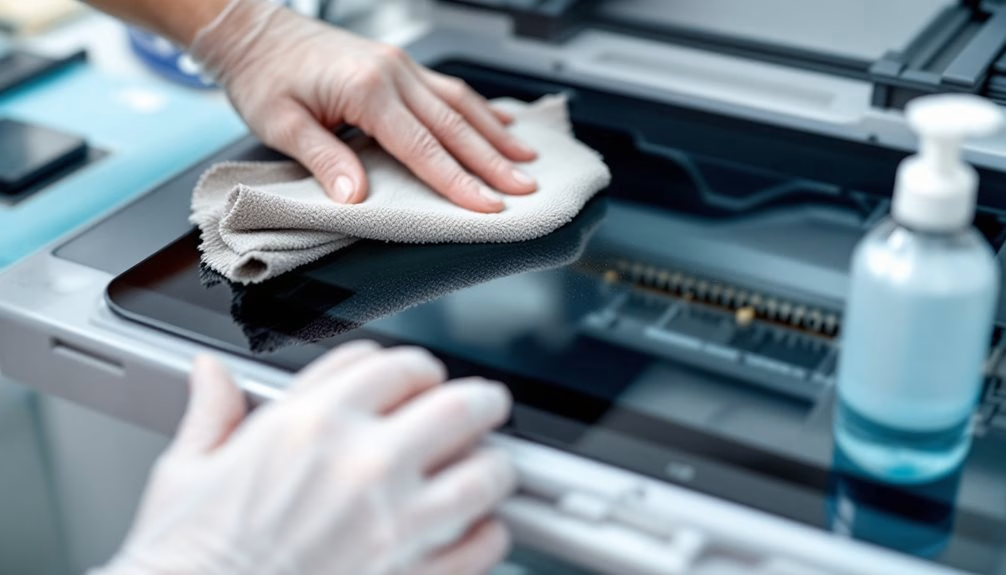
Although modern copiers are built to withstand heavy use, daily cleaning practices can greatly extend their lifespan and prevent costly repairs.
We recommend wiping down the glass surface daily with a soft, lint-free cloth to remove fingerprints and smudges that can affect print quality.
Don’t forget to empty the paper catch tray and check for paper bits in the feed path.
At the end of each day, power down your machine properly rather than simply unplugging it. This allows internal components to reset correctly.
Consider scheduling regular preventive maintenance checks with factory-trained technicians to identify and address potential issues before they cause significant downtime.
Proper Paper Selection and Storage Techniques
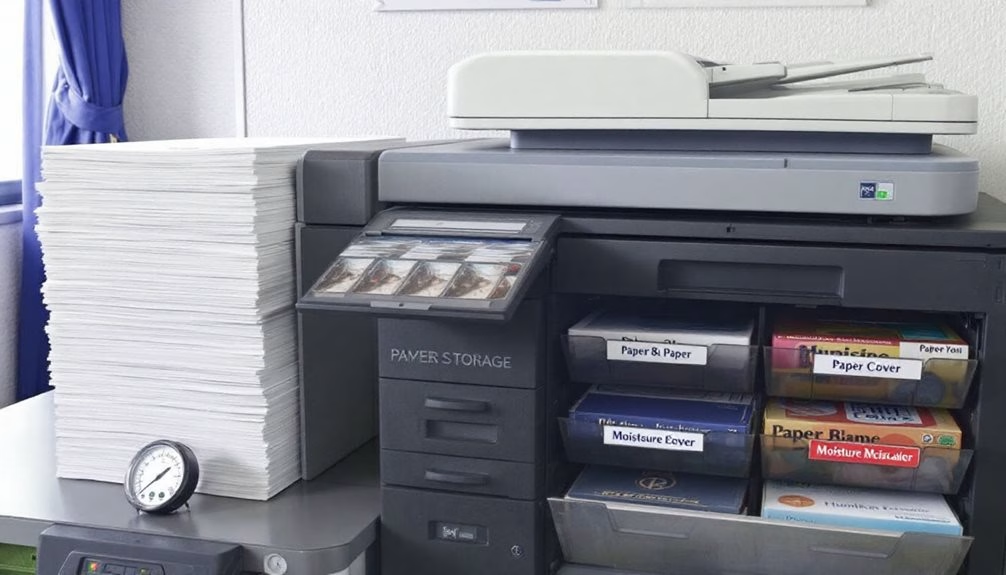
We’ll now explore how proper paper selection and storage directly impacts your copier’s longevity.
Using the correct paper type prevents jams and reduces wear on internal components, while controlling humidity and maintaining dust-free storage prevents moisture damage and contamination.
These simple yet effective practices can dramatically reduce maintenance costs and extend your machine’s useful life. Regular maintenance from factory-trained technicians helps ensure optimal performance and further extends equipment lifespan.
Paper Type Matters
The three most critical decisions you can make about paper dramatically impact your copier’s lifespan.
First, select the weight recommended for your specific model—heavier isn’t always better.
Second, choose paper with appropriate smoothness; overly rough sheets increase wear on critical components.
Third, use high-quality, dust-free paper to prevent debris accumulation.
We’ve found that bargain-brand paper often contains more dust and debris, which gradually builds up inside your machine.
When we invest in acid-free, properly sized paper specifically designed for copiers, we’re not just improving print quality—we’re extending the life of our valuable office equipment.
Humidity Control Tips
Because humidity fluctuations can severely damage your copier’s internal components, controlling your paper’s environment should be a top priority.
We’ve found that proper storage techniques can prevent many common paper-related issues that lead to costly repairs.
- Store paper in climate-controlled areas between 68-78°F with 35-55% relative humidity
- Keep unopened reams in their original packaging until needed
- Allow cold paper to acclimate to room temperature before loading
- Use a moisture meter to monitor storage conditions
- Rotate paper stock regularly, using oldest supplies first
These practices will help us all maintain smoother operations and extend our copiers’ lifespans considerably.
Dust-Free Storage Essentials
Dust particles, often overlooked in office environments, pose a serious threat to your copier’s internal components. They can accumulate on sensors, rollers, and scanning glass, causing paper jams and degrading image quality.
We recommend storing paper in closed cabinets or drawers rather than exposed shelves.
Always keep your paper in its original packaging until use, and only open what you’ll need for the day.
Choose high-quality, dust-free paper designed specifically for copiers.
Avoiding Common User Mistakes That Damage Components
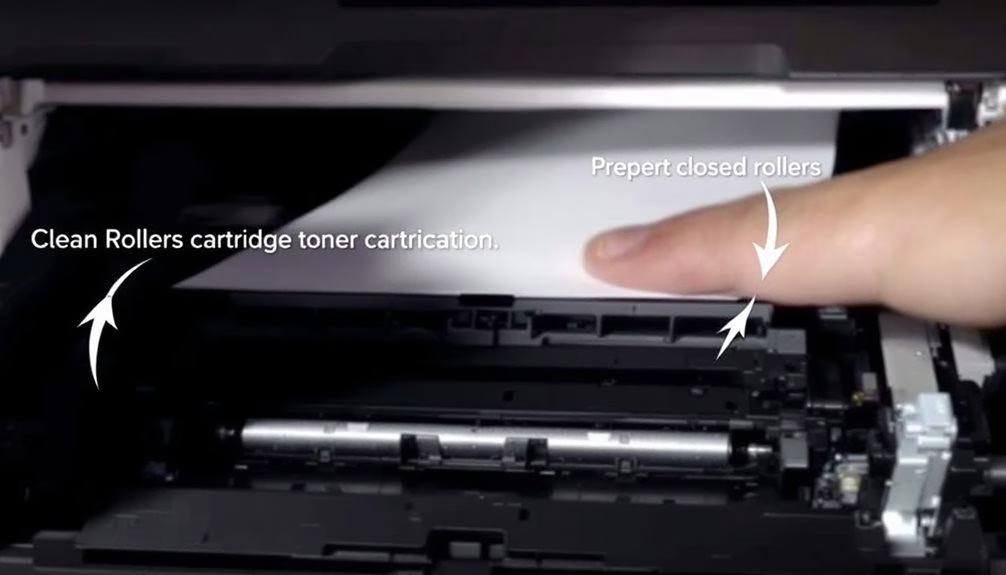
While proper maintenance routines extend your copier’s life, even the most diligent maintenance schedule can’t overcome daily user errors that silently damage internal components.
Let’s explore the most common mistakes we all make and how we can avoid them together.
- Forcing jammed paper out instead of following removal procedures
- Using incorrect paper weights that strain feed mechanisms
- Closing scanner lids forcefully on delicate glass surfaces
- Ignoring warning lights that indicate developing problems
- Pulling printed pages before they’ve fully exited the machine
These simple adjustments to our daily habits will help guarantee we’re protecting our shared investment and keeping repair costs down for everyone.
Following a regular preventative maintenance checklist can help eliminate up to 70% of common printer problems before they require professional intervention.
Creating an Effective Preventive Maintenance Schedule
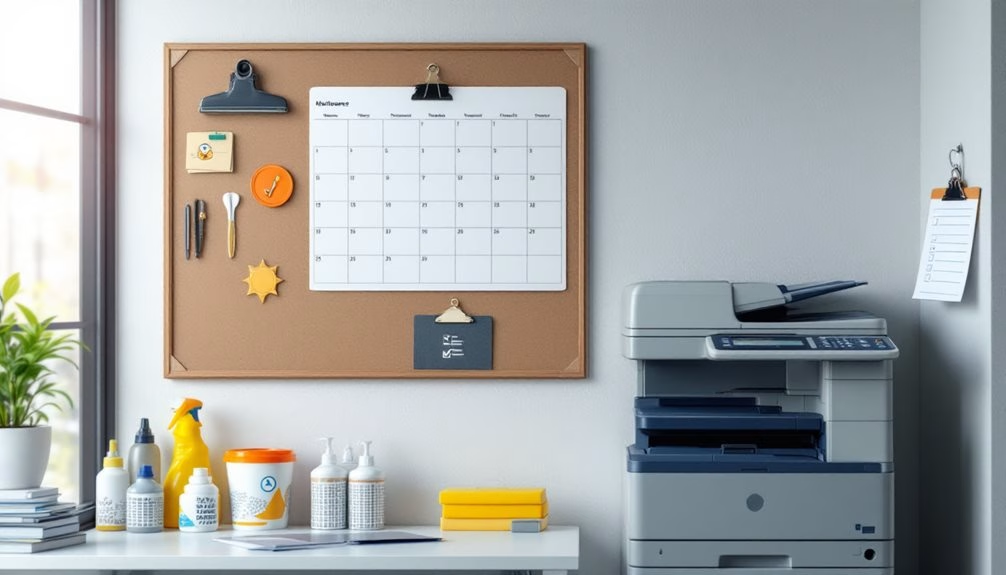
We’ve found that establishing a clear preventive maintenance schedule is key to extending your copier’s lifespan.
Daily tasks like removing paper dust and checking paper trays can be complemented by quarterly deep cleaning of internal components and professional inspections.
Maintaining a detailed maintenance log helps track service history, identify recurring issues, and provides valuable documentation for warranty claims or when troubleshooting problems.
Our certified technicians are always ready to provide expert assistance with maintenance routines that ensure exceptional reliability of your equipment.
Daily vs. Quarterly Tasks
An effective preventive maintenance schedule divides tasks by frequency, separating daily activities from those performed quarterly or less often.
We’ve found that consistent daily attention prevents most major issues, while quarterly maintenance addresses deeper wear patterns.
Daily tasks keep your copier running smoothly without disrupting workflow:
- Wipe down the document glass and control panel
- Remove paper debris from output trays
- Check and refill paper supplies
- Empty waste toner containers when indicated
- Inspect for paper jams and clear them properly
Quarterly tasks require more time but prevent costly breakdowns.
Together, we’ll extend your copier’s lifespan while maintaining peak performance.
Maintenance Log Benefits
Consistency forms the backbone of any successful copier maintenance program, which is why we strongly recommend implementing a maintenance log.
This simple tool transforms random upkeep into a structured system everyone can follow. Your log creates accountability, tracking who performed what task and when.
When we document cleaning dates, toner replacements, and service calls, we gain valuable insights into our machine’s performance patterns.
By reviewing these records, we’ll spot recurring issues before they become expensive problems. Plus, when technicians visit, they’ll appreciate our detailed history—often leading to faster diagnoses and repairs.
Join the community of organized office managers who’ve extended their copiers’ lifespans through diligent documentation.
Optimizing Environmental Conditions for Your Copier
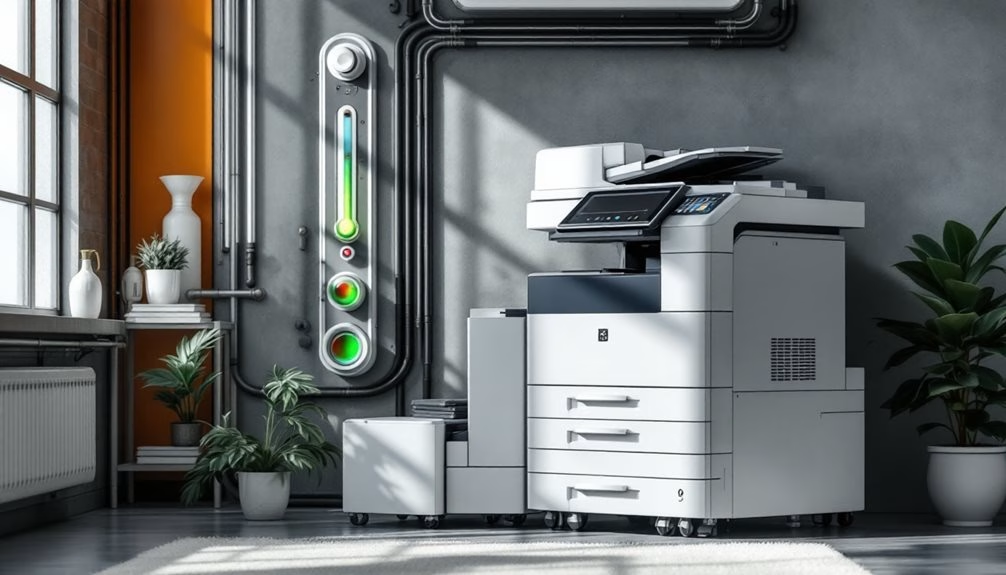
The environment surrounding your copier plays a crucial role in determining its longevity and performance.
We’ve found that maintaining ideal conditions can prevent many common issues that lead to premature breakdowns.
Creating the right setting for your machine isn’t complicated but requires attention to several key factors.
- Keep humidity between 30-60% to prevent paper jams and static buildup
- Maintain room temperature around 68-75°F (20-24°C) for ideal operation
- Position copiers away from direct sunlight to protect sensitive components
- Guarantee adequate ventilation to disperse heat and toner particles
- Minimize dust exposure by cleaning surrounding areas regularly
Implementing proactive maintenance protocols can further extend equipment life while reducing the frequency of service calls and associated downtime.
Together, we can greatly extend your copier’s lifespan.
When and How to Address Minor Problems Before They Escalate
Minor issues with your copier often transform into major repairs if left unattended, much like small health symptoms can develop into serious conditions. We recommend addressing these warning signs immediately to save both time and money.
| Warning Sign | Recommended Action |
|---|---|
| Paper jams | Clear path, check for debris |
| Strange noises | Power off, locate source |
| Streaks on copies | Clean glass, check toner |
| Error codes | Document code, consult manual |
| Slow performance | Restart, check memory usage |
Frequently Asked Questions
How Does Humidity Affect My Copier’s Performance and Lifespan?
High humidity causes paper jams and electrical problems in our copiers. We’ll get better performance and longevity when we keep humidity between 35-55% in our workspace. Let’s use dehumidifiers when needed.
Can Using Third-Party Toner Void My Copier’s Warranty?
Yes, using third-party toner can void your warranty. We recommend sticking with manufacturer-approved supplies to protect your investment. If you’re considering alternatives, check your warranty terms first.
What’s the Maximum Monthly Volume My Copier Can Handle Safely?
We can’t give a specific figure without knowing your copier model. Check your manual for the “recommended monthly volume” – staying within this limit prevents excessive wear and guarantees longevity.
How Do Software Updates Impact My Copier’s Functionality?
Software updates improve your copier’s security, fix bugs, add features, and enhance performance. We recommend installing them regularly to keep your machine running smoothly and protect your network from vulnerabilities.
When Should I Consider Replacement Versus Continued Maintenance?
We recommend replacement when repair costs exceed 50% of a new machine’s price, downtime impacts productivity, or when you need features unavailable through upgrades. Regular maintenance extends life until then.
Expert Final Thoughts
By following these simple maintenance practices, we’re not just extending our copier’s lifespan—we’re protecting our investment. We’ve seen how daily cleaning, proper paper selection, and preventive maintenance make all the difference. Remember, we don’t need expensive solutions; we just need consistency. When we address minor issues immediately and optimize environmental conditions, we’ll enjoy reliable performance for years to come.
About the Expert
Rafael M.
CEO of JR Copier
With over 35 years of hands-on experience in the copier and office printer industry, Rafael brings unparalleled expertise to every client interaction. His journey from service technician to CEO provides him with comprehensive understanding of all aspects of the business.
Areas of Expertise: Copier and printer sales, equipment leasing strategies, maintenance solutions, and managed print services. Rafael's deep industry knowledge ensures clients receive expert guidance, transparent pricing, and exceptional service for all their office equipment needs.
Connect on LinkedIn